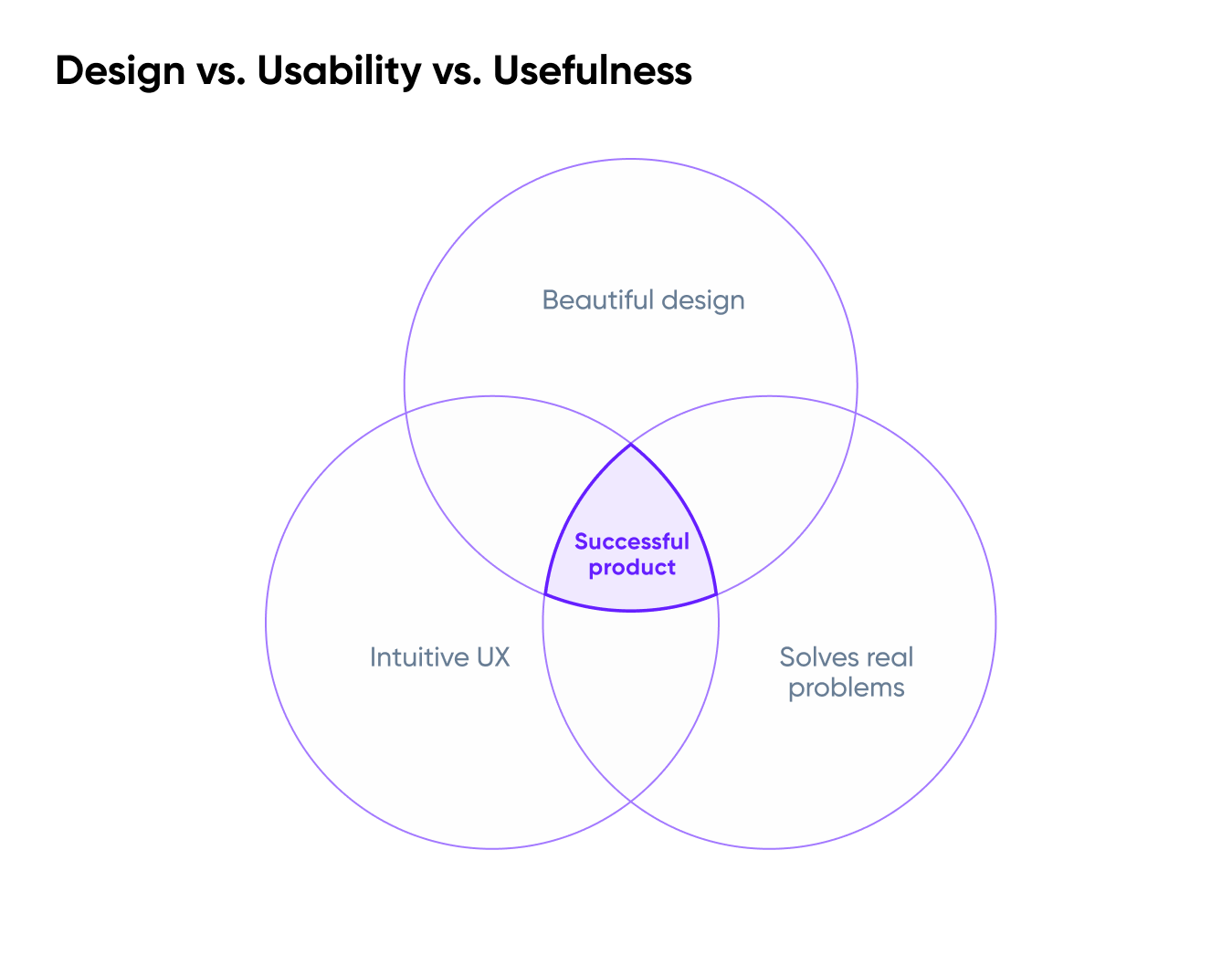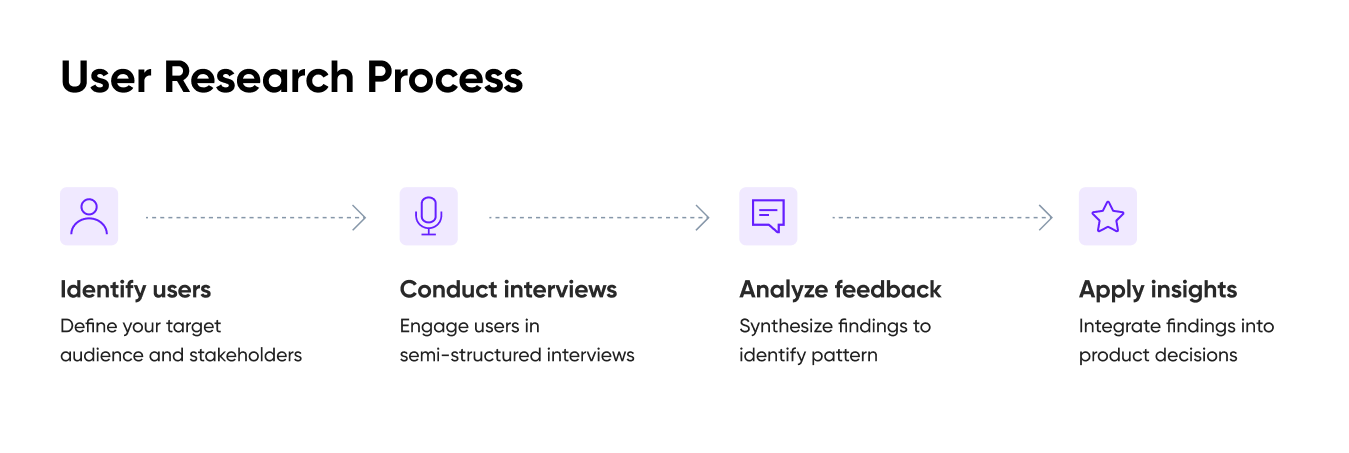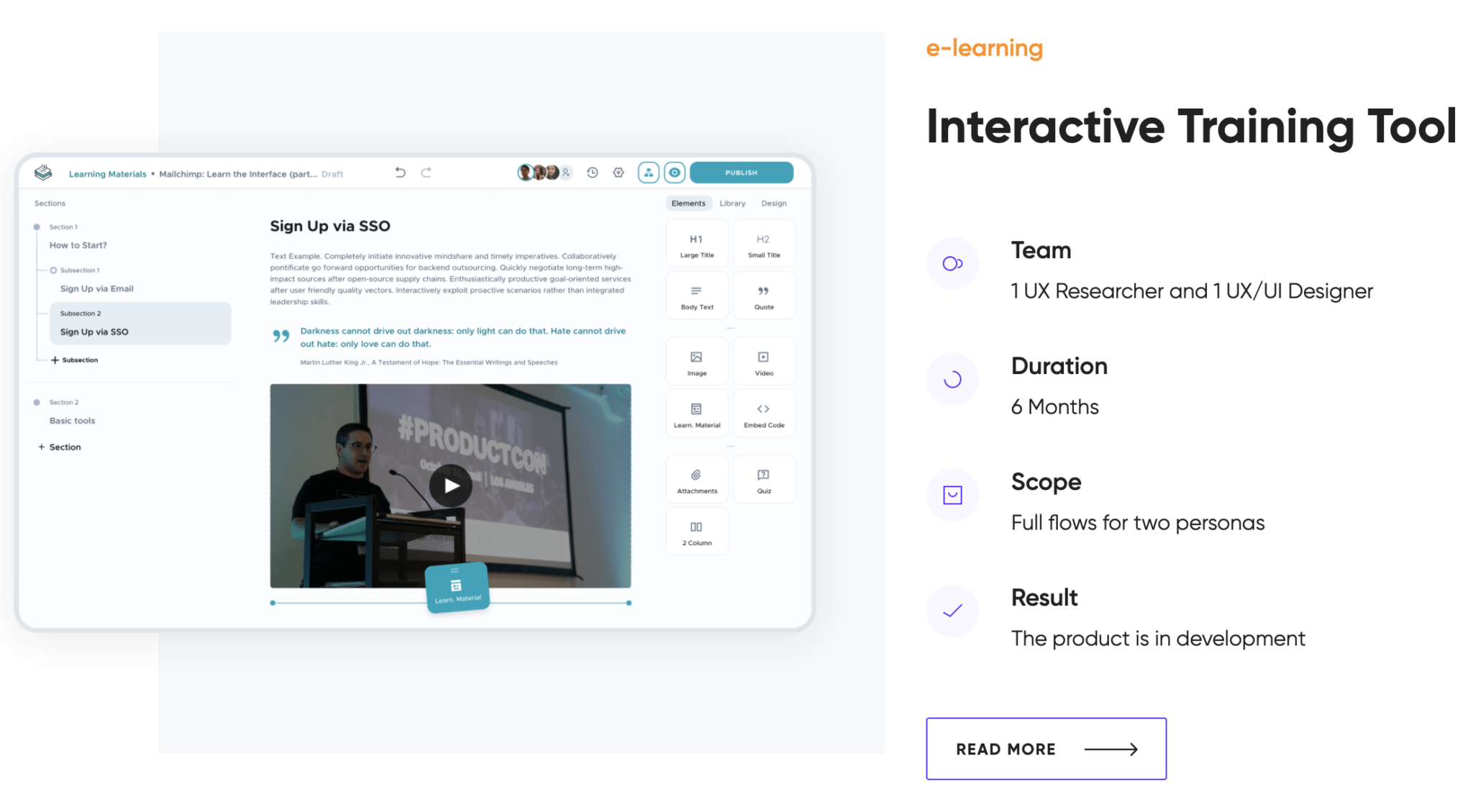You have a great idea. Fantastic! They say a good idea is the heart of any business success.
The next step might seem obvious: find a designer to make the UI of this product shiny and “the buttons on the screen look so good you’ll want to lick them” (yep, straight from Steve Jobs himself).
But you’re a smart, thoughtful client, and you know that a pixel-perfect, polished UI alone won’t cut it. You need a strong UX competency on board, so the interface is easy to use and intuitive. Good!
The thing is, you can have the most gorgeous design in the world… but people still might not use your product. Why could that be? Maybe the design isn’t “beautiful” enough, or perhaps the interactions aren’t seamless enough? Maybe it’s missing some good onboarding? Or maybe—just maybe—it’s because users don’t find your product useful.
A successful product has to be intuitive, solve real problems, and bring value to users’ lives. And that’s exactly where user research comes in, helping you create something people actually want.

Why targeted user research matters
Over the last few years, we’ve successfully completed more than 100 design projects, and let me tell you—user research has saved countless ideas from landing face-first in the dirt.
Most products don’t fail because of ugly design or buggy code. The harsh reality is that 70% of startups fail because they try to solve problems that don’t exist. Almost all products solve some problems but these problems are not big or painful enough for the target audience.
The hard part is to gauge the size of the problem, the potential gain for users, and the effort required to solve it.
Common mistakes most product owners make (and why we get it)
Here’s the usual story for first-time product owners: they have an idea, maybe even a few designs that a third party worked on. But time has passed, and now they are in a hurry to revamp their product because what might have looked great yesterday looks outdated today.
Or maybe they already launched some time ago, and the design looks somewhat obsolete. It might seem like a refreshed design is the only step that separates them from success in the eyes of the target audience.
And we totally understand this need for speed! It seems like time is flying and something has to be done right now. Any putting off is dangerous. But rushing to redesign without checking the basics almost always backfires. Here’s why:
- jumping straight to design feels faster, but if no one wants your product, you’re speeding to nowhere;
- if your product doesn’t actually solve a problem, users won’t stick around;
- if you don’t know what else is out there, you might end up building something that users already have, but better;
- without real feedback, it’s easy to believe everyone’s as excited as you are, but reality often says otherwise.

Much like Maslow’s hierarchy, Aarron Walter’s hierarchy of user needs defines basic user needs that interfaces must fulfill before more advanced needs can be addressed.
Let’s do a small retrospective. What could you do to avoid this frustrating situation or at least to minimize the risk of producing a product no one wants to use?
How do you avoid all this?
The answer is differentiation. Your product needs something that makes it not just different, but meaningfully different.
This sounds easy but how do you know what is the exact way you need to be different? You may risk guessing. You might trust your gut instinct. Or you could get the answer straight from the people who’ll actually use the thing. The last one sounds a lot more reliable than guessing, doesn’t it?
This is where targeted user research shines.
Your product needs to make money; after all, that’s what a business is for. To get there, it has to do more than look good. It has to genuinely meet user needs. If you don’t know your users, you can’t serve them. To bring them value and, in turn, get value back, you need to know who they are, what they care about, and what they’re willing to pay for.
But what does it even mean to “know your users”? It’s not about knowing their age range or favorite apps. To truly understand users, you need to know:
- what are they aiming to achieve with a product like yours?;
- what challenges do they run into that prevent them from reaching those goals?;
- what are the pain points they experience that could motivate them to try a new product or service?;
- are they already putting in time, energy, and money to address this issue?;
- is it a minor inconvenience or a major roadblock in their daily lives?
It’s a lot to uncover. A mass of unknowns and tons of uncertainties. The main goal of the user research is to minimize uncertainty and the risks of failure.

How to prepare for a user interview?
There are plenty of methods for targeted user research, but when it comes to learning about users’ problems, needs, and frustrations, the major technique is user interviews.
While “interview” might sound like a casual chat over coffee, it’s actually a highly strategic process that involves thorough preparation, careful listening, and zero bias, followed by a lot of analysis.
The goal here is to learn about the user rather than convince them that your product is awesome and fish for compliments.
Here’s a self-check: Have you ever asked users questions like these?
- “do you like it?”
- “would you use it?”
- “would you buy it?”
- “it’s useful, isn’t it?”
- “what other features are you missing here?”
If so, this is a surefire indicator that you were doing interviews wrong and it would be better to delegate it to an expert.
What if you slow down and allow yourself to do the research? Yes, you will need to spend some time, and postpone the actual “designing”. But this price is an investment, I would say. You will learn whether the users have a problem you are trying to solve. You will learn how painful the problem is. Or you might even learn there’s no problem whatsoever.
User research in action: Case study
Now, let’s talk real-life.
Recently we had a client come to us with what seemed like a straightforward job: revamp an old design that was outdated and had multiple usability flaws. It was a tool for creating interactive content and training materials.
After a quick look at the product we realized what was missing: Point of Difference—a strong differentiator among other similar products on the market. This tool had plenty of competitors, many of which were stronger and more polished. We could have just fixed the obvious usability and visual issues, but that alone wouldn’t make this product stand out.
Instead, we ran user interviews with 12 instructional designers using a semi-structured interview method. By the end, we had uncovered:
- 22 findings: Real pain points and needs that users shared;
- three key patterns: Issues that came up repeatedly across three or more user interviews.
One huge frustration that kept coming up was that users were tired of juggling a million different apps to get their work done. We called this the “All-in-One Tool” insight. Here’s some actual feedback we heard:
“The bottom line is I really would rather not be using the separate tool for it. I really wish that the screen capture and the video capture was integrated into the authoring tool, I don’t like using a separate tool.” [Adam: 53:21].
“My biggest issue is having to jump between multiple applications.” [Ian: 32:11].
“The fact that it is not all in one place. You know, I’m recording the videos using Camtasia, converting them, then uploading them to Wistia, creating the embed code, then embed code in Wistia and ZenDesk. So it’s in multiple places, it’s kind of the hardest part.” [Sean: 4:15].
With these insights, we didn’t just know our users better—we knew their specific pain points and priorities. This empathy allowed us to design a solution that addressed what instructional designers actually needed. And because we’d established a pool of engaged users, we could come back to them to validate our design ideas as we moved forward.
After the research phase, we agreed with the client on what functionality should go into the MVP and prepared an estimate for the design phase. Some of their initial ideas got pushed aside, while the pain points we kept hearing in user interviews took top priority in the MVP.
The next stage was low-fidelity prototyping. The beauty of low-fidelity wireframes? They’re fast, flexible, and let you test ideas without getting too attached. After sketching out the basics, we moved on to user testing—a design validation phase that entails validating or discarding our hypotheses and assumptions based on users’ feedback.

We used remote moderated user testing, where we could see users interact with the prototype and get live feedback. And let me tell you, there’s no better feeling than hearing positive reactions to features that came directly from user feedback. Both we and the client could see the value these new features brought to the table, making all the research worth it.
At this stage, the product is in the final stages of development and almost ready for launch! We’re excited to see it hit the market soon.
If you want to learn more about what we’ve been up to with this project, you can check it out here.
Targeted user research lowers risks but doesn’t guarantee success
Look, let’s be honest. User research does not guarantee success. What it does do is drastically lower the risk of launching something that no one wants. It helps you nail down at least one of the critical four Ps (Product, Price, Placement, Promotion) so you’re actually bringing something of value to the table.
Good marketing starts with a product that solves a real need or eases a real pain. Products that are “painkillers” (must-haves) do way better than “vitamins” (nice-to-haves). Plus, with research, you get a better handle on pricing, positioning, and how to talk about your product in ways that resonate.
Of course, there is always option #2. You can always skimp on research. Most products do so. Most products never succeed.
P.S.
To get an idea of what deliverables you get as a result of the user interview service, you can review the following report. It is white labeled, of course, and all key findings are blurred but the general idea is clear.
If you have questions or want to chat about how we work, we’d love to set up a quick call.



